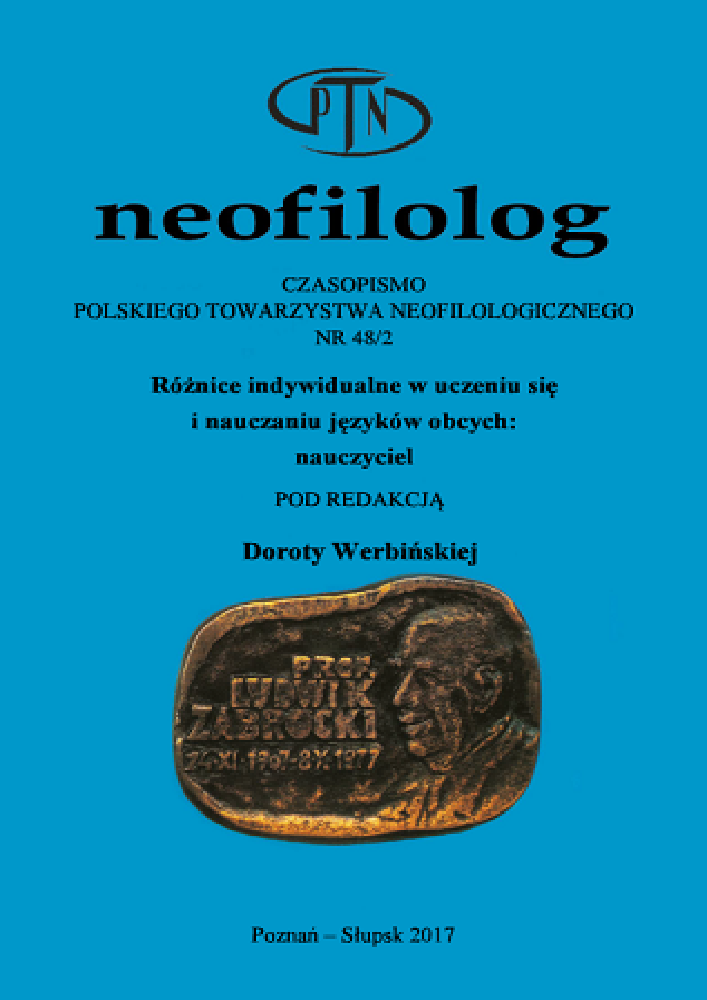Abstrakt
Referring to critical ecological language awareness (Lankiewicz, 2015), autonomy in language learning (Benson, 2011) as well as the non-fixity of the linguistic code manifested by sociocultural and ecological studies (Harris, 1981; Otsuji and Pennycook, 2010), I put forth the need of applying the idea of a variable pedagogical norm, as postulated by Valdman (1989; 1992). The principal objective of the article is to present research elucidating the fact that the use of classroom activities respecting the pedagogical variable norm may contribute to the raising of students’ language awareness in respect to social and cultural linguistic diversity. Ultimately, this new awareness may contribute to the shift of attitudes towards language learning. The application of the variable pedagogical norm is indicative of critical language awareness of the teacher and helps develop a similar equivalent among students. Concluding, I dare say that developing autonomy in language learning seems impossible without the application of the pedagogical variable norm.
Bibliografia
Belczyk, A. 2009. Poradnik tłumacza. Kraków: Idea.
Benson, P. 2011. Teaching and researching autonomy in language learning. Second edition. Harlow: Pearson.
Benson, P. i P. Voller (red.). 1997. Autonomy in language learning. London: Longman.
Brumfit, C. 2001. Individual freedom in language teaching: helping learners to develop a dialect of their own. Oxford: Oxford University Press.
Canagarajah, S. 2007. „The ecology of Global English”. International Multilingual Research Journal 1(2): 89-100.
Canagarajah, S. 2013. Translingual practice. Global Englishes and cosmopolitan relations. New York: Routledge.
Cook, V. 1999. „Going beyond the native speaker in language teaching”. TESOL Quarterly, 33(2): 185-209.
Cook, V. 2014. „Multi-competence”. [online: homepage, http://homepage.ntlworld.com/vivian.c/Writings/Papers/MCentry.htm, ED 9.01.2017].
Cowie, A. 1992. „Multiword lexical units and communicative language teaching”. (w) Vocabulary and applied Linguistics. P. Arnaud i H. Bejoint (red.). Basingstoke UK: MacMillan, str. 1-12.
Danilewicz, T. 2011. Language awareness and second language teacher. Gdańsk: Wydawnictwo Uniwersytetu Gdańskiego.
Donato, R. 1994. „Collective scaffolding”. (w) Vygotskyan approaches in second language research. J. P. Lantolf i G. Appel (red.). Norwood, NJ: Ablex, str. 33-56.
Ellis, R. 1997. Second language acquisition. Oxford introductions to language study. Oxford: Oxford University Press.
ESOKJ (Europejski System Opisu Kształcenia Językowego). http://jows.pl/sites/default/files/ESOKJ_interaktywny.pdf [ED 09.01.2017].
Fairclough, N. 1992. Critical language awareness. London and New York: Longman.
Firth, A. i J. Wagner. 1997. „On discourse, communication, and (some) fundamental concepts in SLA”. Modern Language Journal, 81 (3): 285-300.
Gramsci, A. 1971/1991. Selections from the Prison Notebooks. London: Lawrence & Wishart.
Harris, R. 1981, The Language Myth. London, Duckworth.
Howarth, P. 1998. „Phraseology and second language proficiency”. Applied Linguistics, 19(1): 24-44.
Hutchins, E. 1991. „The social organization of distributed cognition”. (w) Perspectives on socially shared cognition. L. B. Resnick, J. M. Levine i S. D. Teasley (red.). Washington, DC: American Psychological Association, str. 283-307.
Jenkins, J. 2007. English as a lingua franca: Attitude and identity. Oxford: Oxford University Press.
Jones, M i S. Haywood. 2004. „Facilitating the acquisition of formulaic sequences: An exploratory study in an EAP context”. (w) Formulaic sequences. Acquisition, processing and use. N. Schmitt (red.). Amsterdam: John Benjamins, str. 269-300.
Kramsch, C. 2002. “Standard, norm and variability in language leanring: A view from foreign language research”. (w) Pedagogical norms for second and foreign language learning and teaching. S. Gass, K. Bardovi-Harlig, S. Sieloff Maganan, J. Waltz (red.). Amsterdam and Philadelphia: John Benjamins, str. 59-80.
Kotowska, A. i H. Lankiewicz 2015. „Defiing attitudes towards language learning: Autonomy and second language major”. Forum Filologiczne Ateneum, 1/3, 47-64.
Kumaravadivelu, B. 2012. Language teacher education for a global society: A modular model for knowing, analyzing, recognizing, doing and seeing. New York and London: Routledge.
Lankiewicz, H. 2013. „Dialekt w klasie językowej w świetle podejścia ekologicznego do nauczania języka”. (w) Rola dyskursu edukacyjnego w uczeniu się i nauczaniu języka obcego. M. Pawlak (red.). Kalisz–Poznań: Wydział Pedagogiczno-Artystyczny UAM w Kaliszu, Uniwersytet im. Adama Mickiewicz w Poznaniu, str. 9-29.
Lankiewicz, H. 2015. Teacher language awareness in the ecological perspective. Gdańsk: Wydawnictwo Uniwersytetu Gdańskiego.
Otsuji, E. i A. Pennycook. 2010. „Metrolingualis: fixity, fluidity and language in flux”. International Journal of Multilingualism, 7(3): 240-254. [online: http://www.academia.edu/4889733/Metrolingualism_fixity_fluidity_and_language_in_flux, ED 9.01.2017].
Smuk, M. 2016. Od cech osobowości do kompetencji savoir-être. Rozwijanie samoświadomości w nauce języków obcych. Lublin, Warszawa: Werset.
Swain, M. 1997. „Collaborative dialogue: Its contribution to second language learning”. Revista Canaria de Estudios Ingleses 34: 115-32.
Valdman, A. 1989. „Classroom foreign language learning and language variation: The notion of pedagogical norms”. (w) The dynamic Interlanguage: Empirical studies in second language acquisition. M. R. Eisenstein (red.). New York: Plenum Press, str. 261-277.
Valdman, A. 1992. „Authenticity, variation, and communication in the foreign language classroom”. (w) Text and Context. Cross-disciplinary perspectives on language study. K. Kramsch, C. i S. McConnell-Ginet (red.). Lexington MA: D.C. Heath, str. 79-97.
van Lier, L. 2004. The ecology and semiotics of language learning: A sociocultural perspective. Boston: Kluwer Academic Publishers.
Widła, H. 2007. L'acquisition du français – langue troisième: problèmes méthodologiques et implications pratiques. Katowice: Wydawnictwo Uniwersytetu Śląskiego.
Widła, H. 2016. „Zmierzch bilingwizmu i jego skutki”. Neofilolog, 47/1: 9-20.
Wilczyńska, W. 2002. „Podmiotowość i autonomia jako wyznaczniki osobistej kompetencji komunikacyjnej”. Autonomizacja w dydaktyce języków obcych. Doskonalenie w komunikacji ustnej. (w) W. Wilczyńska (red.). Poznań: Wydawnictwo Naukowe UAM, str. 51-67.
Wolfram, W., T. C. Adger i D. Christian. 1999. Dialects in schools and communities. Mahwah. NJ: Laurence Erlbaum.
Wygotski, L. S. 1971. „Problem nauczania i rozwoju umysłowego w wieku szkolnym”. (w) L. S. Wygotski,Wybrane prace psychologiczne. Warszawa: PWN, str. 531-547.
Licencja
Prawa autorskie (c) 2017 Hadrian Lankiewicz

Utwór dostępny jest na licencji Creative Commons Uznanie autorstwa – Bez utworów zależnych 4.0 Międzynarodowe.
Przedstawiany utwór (artykuł) upubliczniany jest na podstawie umowy z autorem i na licencji Creative Commons Attribution-NoDerivatives 4.0 International (CC BY-ND 4.0).
Użytkownicy mają obowiązek podania wraz z rozpowszechnionym utworem, informacji o autorstwie, tytule, źródle (odnośniki do oryginalnego utworu, DOI) oraz samej licencji;
- bez tworzenia utworów zależnych,
- utwór musi być zachowany w oryginalnej postaci.
Uniwersytet im. Adama Mickiewicza w Poznaniu zachowuje prawo do czasopisma jako całości (układ, forma graficzna, tytuł, projekt okładki, logo itp.).
